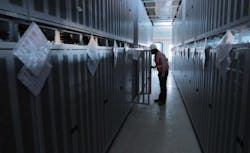PG&E proposes 1.6-GW Li-Ion Battery expansion in California
The Pacific Gas and Electric Company (PG&E) wants to build nine battery energy storage projects for a combined 1,600 MW capacity in California.
The projects will help further integrate renewable energy resources and improve the reliability of the state’s electric system. The plan requires state regulatory approval.
All of the sites will have lithium-ion battery energy storage technology with a 4-hour discharge duration. A 15-year Resource Adequacy agreement has been executed for each of the projects.
The projects are as below:
1. The Beaumont Energy Storage project will comprise a 100 MW stand-alone, transmission-connected battery energy storage resource.
2. The Edwards Sanborn Energy Storage project will comprise a 169 MW stand-alone, transmission-connected battery energy storage resource. It will be located in Mojave.
3. The Canyon Country Energy Storage project in Santa Clarita will comprise an 80 MW stand-alone, transmission-connected battery energy storage resource.
4. The MOSS350 Energy Storage project in Moss Landing will comprise a 350 MW stand-alone, transmission-connected battery energy storage resource. Vistra has a long-term agreement with PG&E on Moss Landing energy storage (pictured above), which already has close to 350 MW of capacity in operation.
5. The Inland Empire Energy Storage project in Rialto will comprise a 100 MW battery energy storage resource.
6. The Corby Energy Storage project comprises a 125 MW battery energy storage resource. It is located in Vacaville.
7. The Kola Energy Storage project comprises a 275 MW stand-alone, transmission-connected battery energy storage resource. It will be located in Tracy.
8. The Nighthawk Storage project in Poway comprises a 300 MW stand-alone, transmission-connected battery energy storage resource.
9. The Caballero Energy Storage project in Nipomo will comprise a 99.7 MW battery energy storage resource.
The Beaumont Energy Storage project, the Edwards Sanborn Energy Storage project and the MOSS350 Energy Storage project are scheduled to come online in August 2023. The Canyon Country Energy Storage project is expected to come online by October 2023. The Inland Empire Energy Storage project is scheduled to come online by April 2024. The remaining four projects are scheduled to come online by June 2024.
The projects require the approval of the California Public Utilities Commission (CPUC) and will participate in the California Independent System Operator (CAISO) markets. The projects will provide energy and ancillary service to the CAISO-controlled grid.
The CPUC’s June 2021 decision directed all load serving entities in the state to procure 11.5 GW new electricity resources. It will replace electricity generation from the retired plants, like the Southern California natural gas plants and PG&E’s Diablo Canyon Power Plant (DCPP).
About the Author
EnergyTech Staff
Rod Walton is senior editor for EnergyTech.com. He has spent 17 years covering the energy industry as a newspaper and trade journalist.
Walton formerly was energy writer and business editor at the Tulsa World. Later, he spent six years covering the electricity power sector for Pennwell and Clarion Events. He joined Endeavor and EnergyTech in November 2021.
He can be reached at [email protected].
EnergyTech is focused on the mission critical and large-scale energy users and their sustainability and resiliency goals. These include the commercial and industrial sectors, as well as the military, universities, data centers and microgrids.
Many large-scale energy users such as Fortune 500 companies, and mission-critical users such as military bases, universities, healthcare facilities, public safety and data centers, shifting their energy priorities to reach net-zero carbon goals within the coming decades. These include plans for renewable energy power purchase agreements, but also on-site resiliency projects such as microgrids, combined heat and power, rooftop solar, energy storage, digitalization and building efficiency upgrades.
